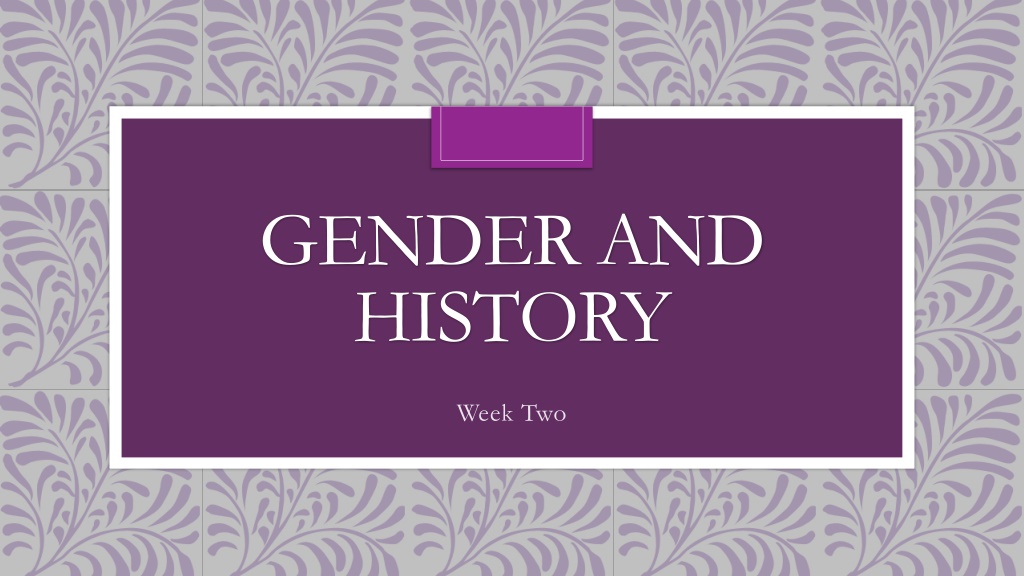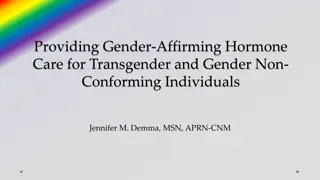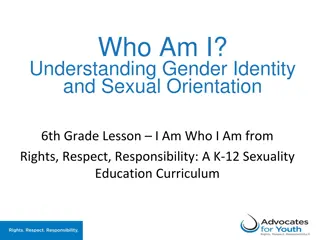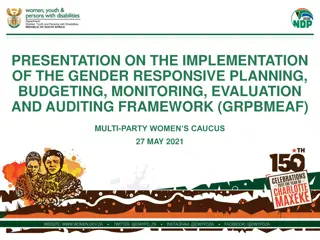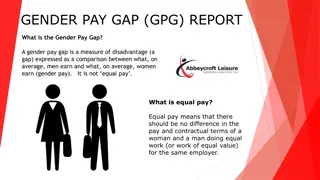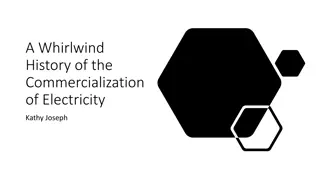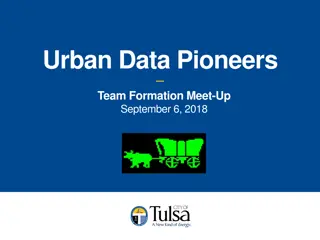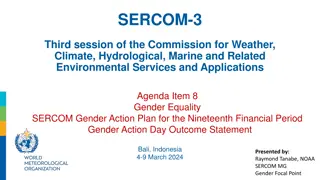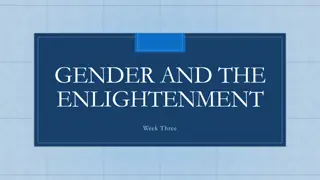Exploring Gender and History: From Antiquarians to Pioneers
The development of history as a discipline from antiquarian pursuits to social history in the 1960s, highlighting key figures like Olive Schreiner and pivotal shifts in historical perspectives towards gender and societal constructs.
Download Presentation

Please find below an Image/Link to download the presentation.
The content on the website is provided AS IS for your information and personal use only. It may not be sold, licensed, or shared on other websites without obtaining consent from the author. Download presentation by click this link. If you encounter any issues during the download, it is possible that the publisher has removed the file from their server.
E N D
Presentation Transcript
GENDER AND HISTORY Week Two
Outline 1. Development of History Antiquarian Discipline 1960s 2. Pioneers Early Work Second-Wave Feminism 3. Revisions Separate Spheres Gender History 4. Recent Developments The Colonial Context Queer History
1. Development of History: Antiquarians Leisure pursuit Narrow field of interest Empirical data Narrative driven No analysis or interpretation Forerunner of social history/archaeology/social science?
1. Development of History: The Discipline Prominent people and events 19thcentury Germany Entry Quality control requirements!! Grand narratives Professional networks Professionalisation and institutionalisation Nationalist
1. Development of History: 1960s Rise of social history / History of the people / History from below. Response to wider social changes in British society anti- institutionalism, collapse of deference, popular nostalgia. Increased access to university. Before WW2 only 2% of 18yr olds went to university and less than a quarter were women. 1960 Anderson Committee led to more diversity. Opens door to new approaches - Marxist History, Annales, Post- colonialism and Women s History.
2. Pioneers: Early Work Mavericks : Ivy Pinchbeck, Alice Clark and Olive Schreiner. Aims: Women s campaigners Demonstrate that women had a history that could be studied and could reshape traditional male narratives. Reveal gender as constructed not natural phenomenon that has changed and will do so again. Criticism: Primitive Accumulation ? Like Antiquarians- little interpretation Little focus on intersectionality.
2. Pioneers - Olive Schreiner (1855-1920) Subjects: colonialism in South Africa, feminism, socialism, prostitution, marriage, pacifism, franchise. New Woman: Independent, well travelled, desirous of economic independence. Story of an African Farm (1883) tells the story of Lyndall, a strong heroine living on an isolated ostrich farm, who controls her own destiny. Widely applauded by feminists. Believed the vote was "a weapon, by which the weak may be able to defend themselves against the strong, the poor against the weak". Primary Sources: Novels widely available and hundreds of letters available online at https://www.oliveschreiner.org/vre?page=295
2. PioneersAlice Clark (1874-1934) Women s rights campaigner Family: women s rights and shoe manufacturing Interests: Female suffrage, temperance and adult education Quaker and pacifist Leadership of National Union of Women's Suffrage Societies WW1: Friends' War Victims Relief Committee aid to European refugees. LSE: The Working Life of Women in the Seventeenth Century (1919) capitalism erodes status of women.
2. Pioneers - Ivy Pinchbeck (1898-1982) LSE: Economic Historian Committee member of Economic History Society Lecturer at Bedford Women s College until 1961. Women Workers and the Industrial Revolution, 1750 1850 (1930) Optimistic view of industrial revolution as advancing role of women. Short term disadvantage for longer term gains. Women actively shaped economic character of Britain not just passive victims of capitalism. Industrialisation allowed women to spend more time at home with children liberating?
2. Second Wave Feminism Revival of feminist activism 1960s Focus: sexuality, contraception, marital rape, equal pay, sexual harassment. Women s history moves from margin to mainstream sub-genre of history. Examples: Sheila Rowbotham s Hidden From History (1973) Marxist but critical of Marxist historians for neglecting women and family. Davidoff & Hall, Family Fortunes (1987) Separate Sphere?
3. Revisions Gender History Gender is what it means to be defined as a man or woman. (Sonya O. Rose) The definition changes over time and space. It is constructed not biologically determined. The construction of gender has a history. Women should not be added to history as a sub-section but should shape perspectives on all areas of history. Notions of gender impact on social relationships.
3. RevisionsGender History Analytical Tool Joan Scott Gender and the Politics of History (1988). Gender should be used as an analytical category for historical investigation. Explore cultural meanings of masculinity and femininity. Primary role of language in the construction of gendered identity (poststructuralism: the construction of meaning through language).
3. Revisions Gender History Masculinities Victor Seidler Rediscovering Masculinity (1989) Legitimize emotion to free men from the chains of patriarchy which oppresses men as much if not more so than women. Masculinity and Femininity binary opposites? Marginalizing women again?
4. Recent Developments Post Colonialism Feminist scholars of the developing world have attacked western feminists for refusing to explore the different meanings that being a woman may have in various class, racial, ethnic or religious contexts. Need to explore complex and contradictory relationships between gender, imperialism, and politics. Antoinette Burton Burdens of History (1994) British feminism based on racial and imperialist ideology
4. Recent Developments. Queer Theory Emerges in the 1970s but more sophisticated work appears since 2000 Sexuality is unstable category shaped by social and cultural factors. Have challenged many established views of Victorian culture and society Sheila Jeffreys The Spinster and her Enemies (1986) - heterosexuality maintains patriarchal power.
Conclusion Women s History still undertaken. Est. of womens history presses e.g. Honno. Est. of journals e.g. Women s History Review Est. organisations e.g. Women s History Network Gender history did not decline with the WLM. Gender embedded into curriculum. Increase in number of professors. Gender and women s history thriving . However
Conclusion Cont. Influence of 3rdwave/lipstick and stiletto feminism? Impact of gender history on broader discipline? Perception of female historians? Why don t more men study gender history? Should men write women s history? Is the inclusion of queer theory and masculinities marginalising women? Does the focus on race and class divide weaken feminist message?
This weeks seminar. Gender and History cont. Key Reading Group 1 John Tosh, Manliness and Masculinities in Nineteenth-Century Britain. Mrinalini Sinha, 'Giving masculinity a history . Group 2 Jane Rendall, 'Uneven developments . Kathryn Gleadle, 'The Imagined Communities of Women's History . Group 3 Richard A. Kaye, 'The New Other Victorians . Sean Brady, Masculinity and Male Homosexuality in Britain.
